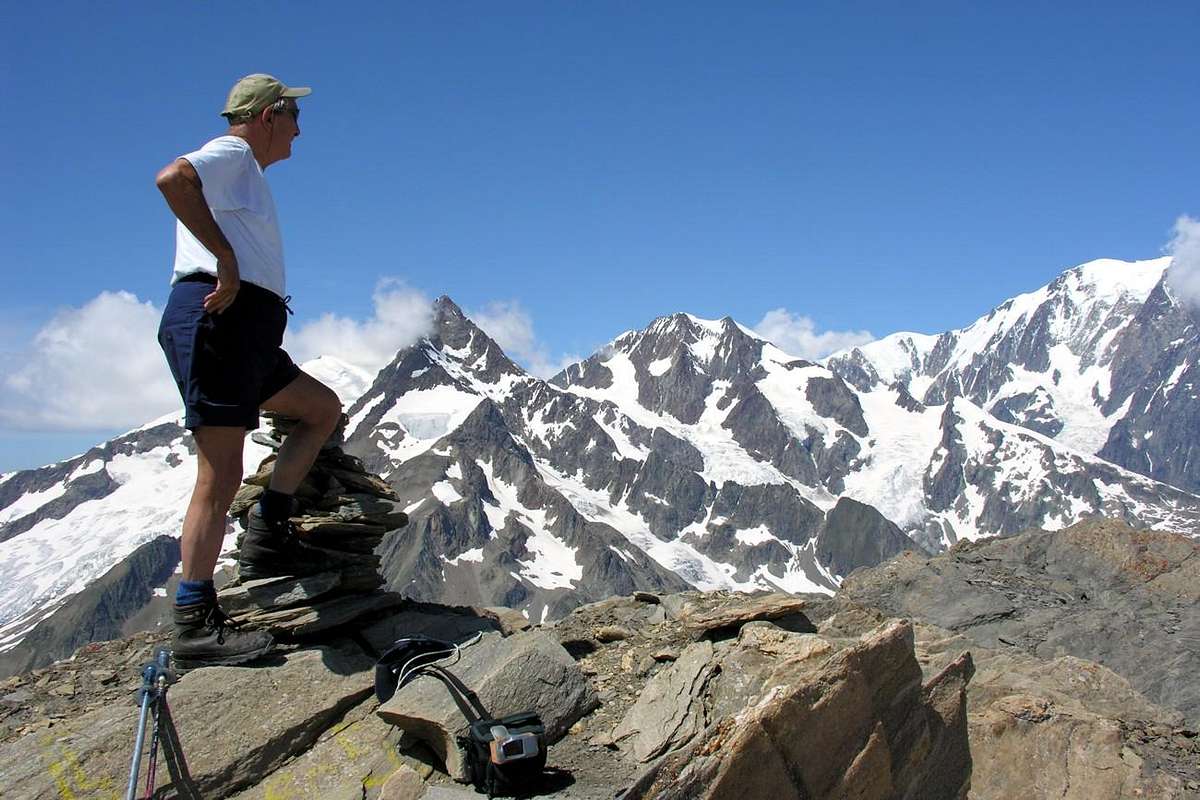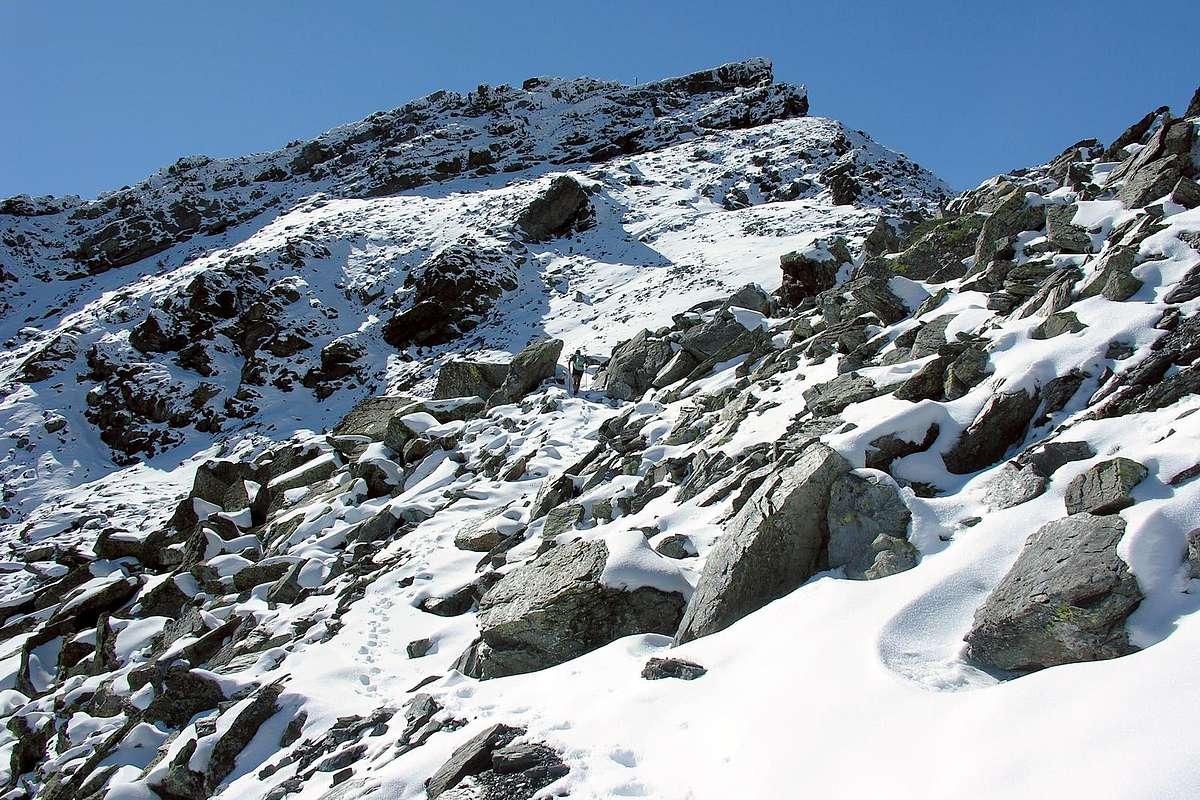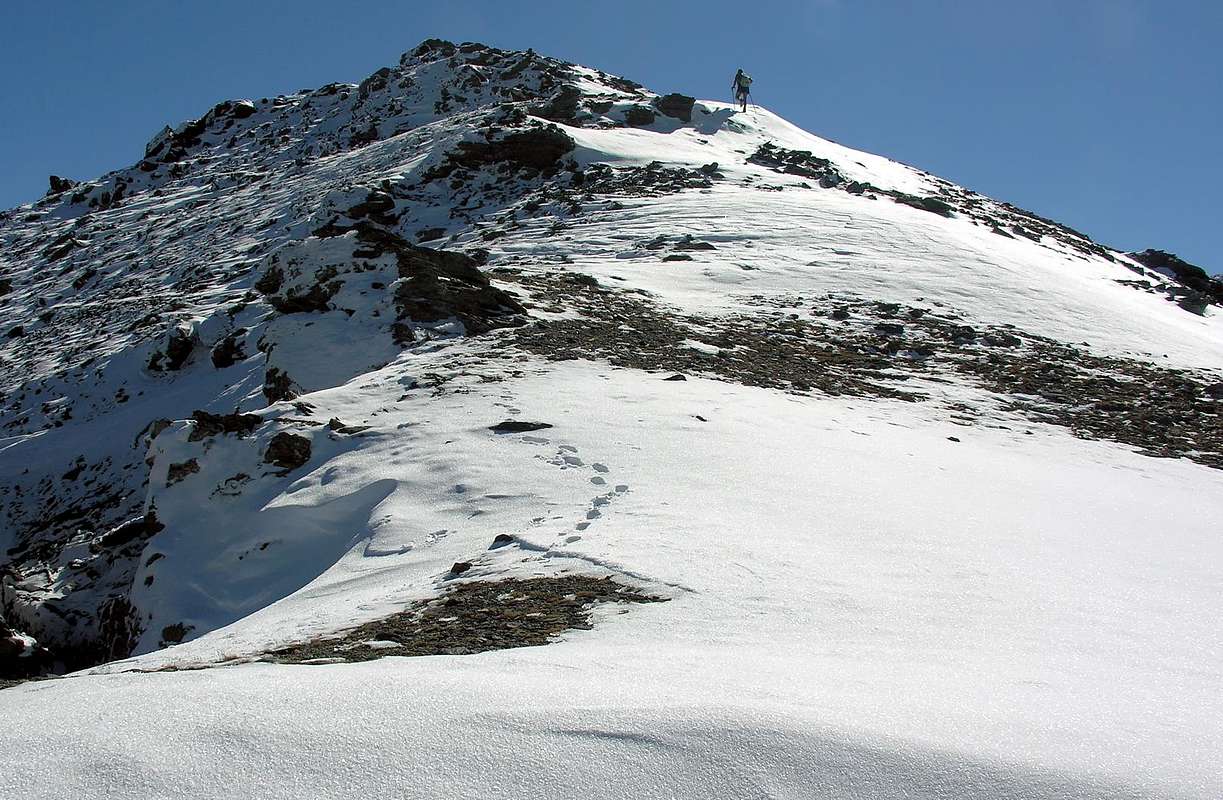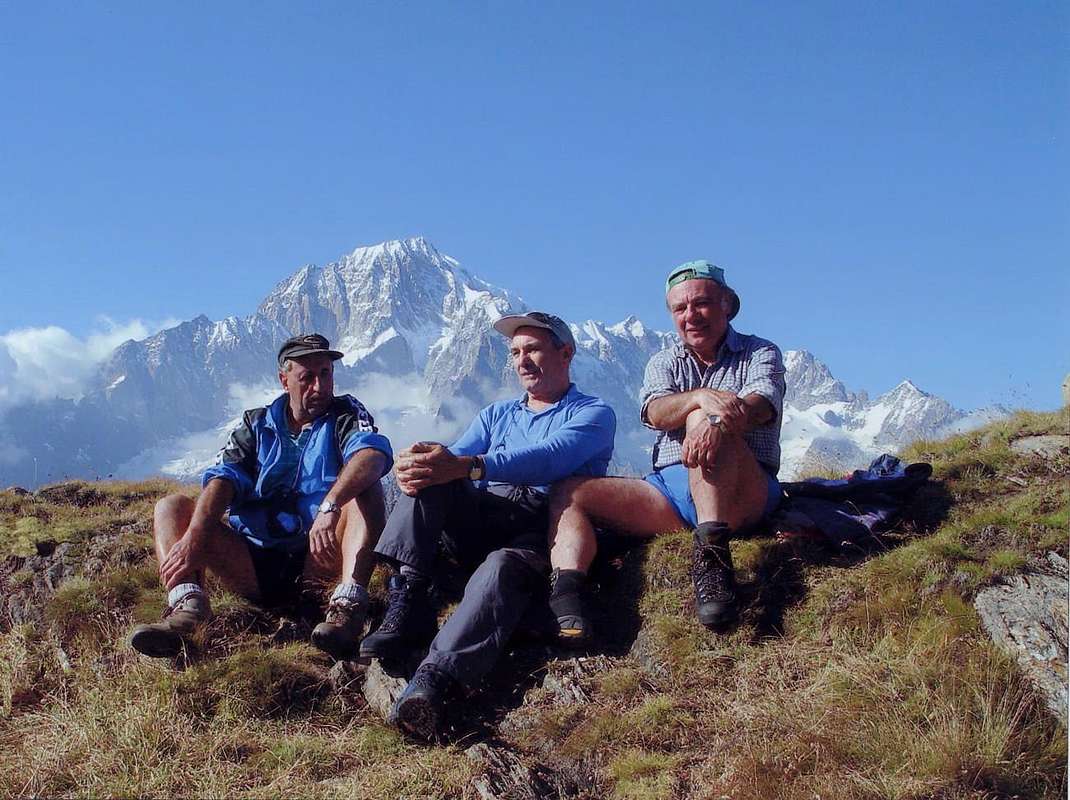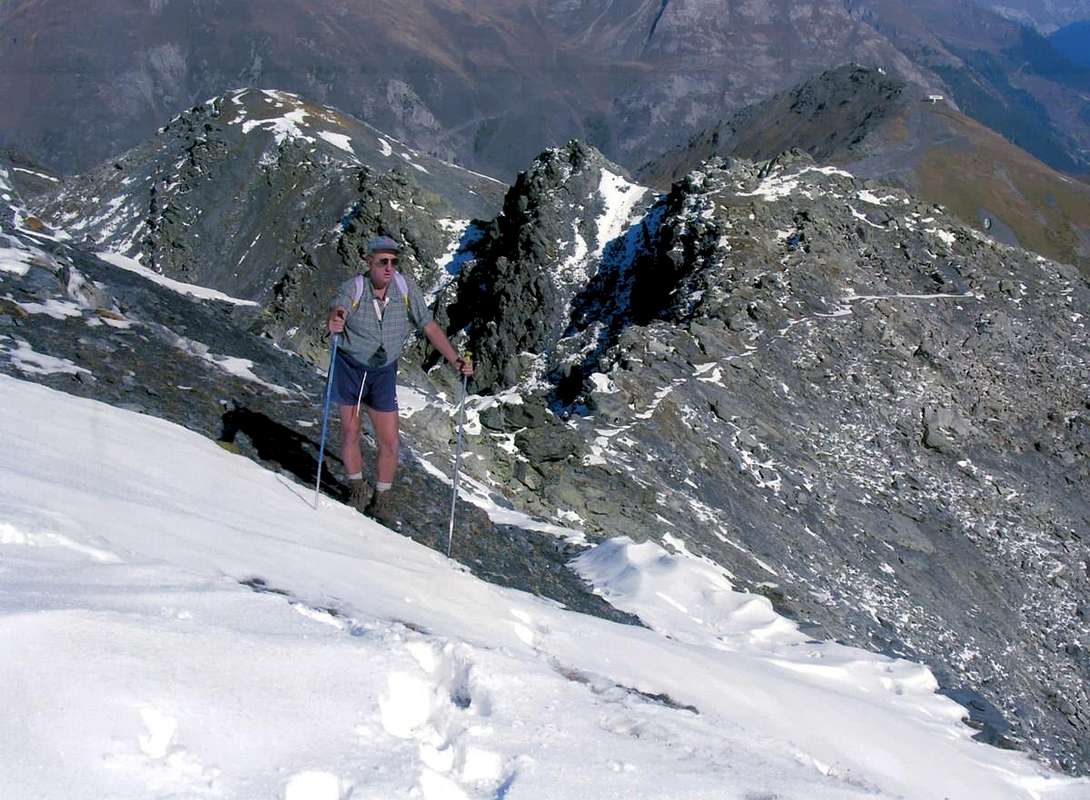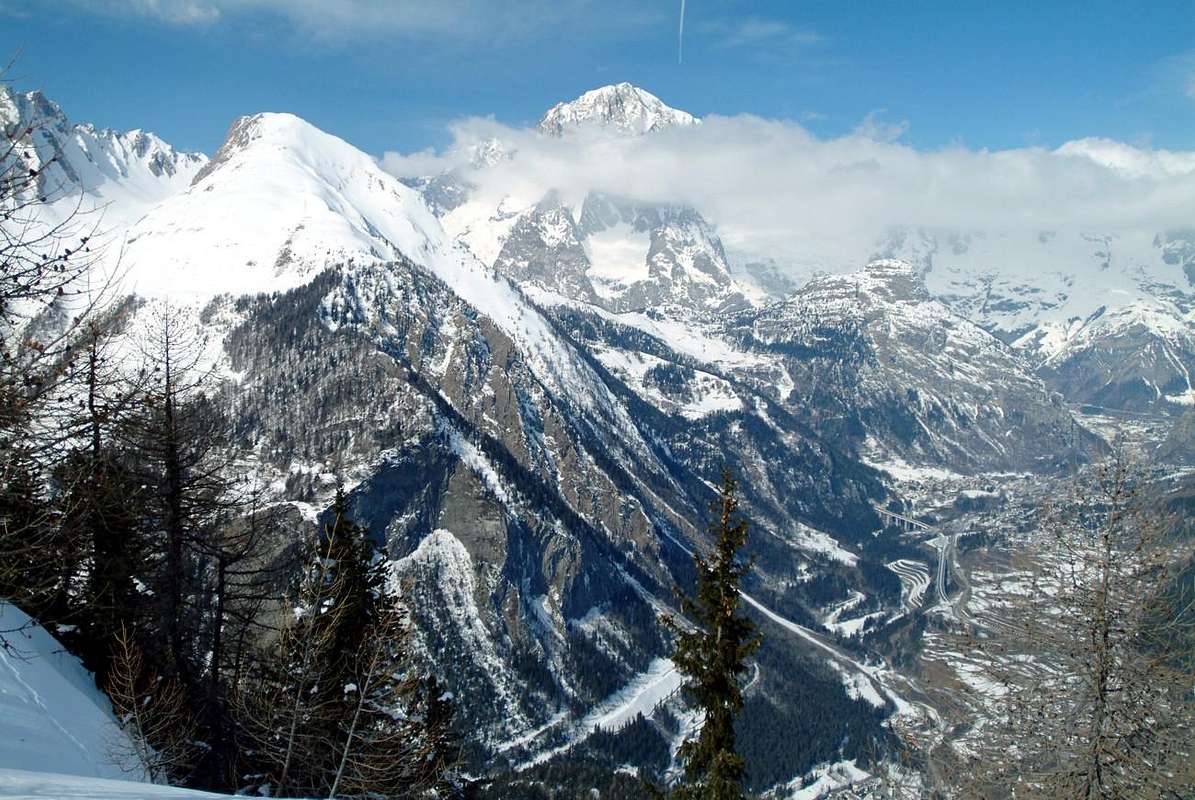On the opposite side of watershed with the Valgrisenche, the ridge down from the Head of Rutor reaching Point Loydon and immediately below the Grand'Assaly, pivot towards the West. Leaving down on this side of the Tarenteise at the entrance of Val d'Isère, stretches towards the small Chain of the three Mounts Fréduaz and Mount Valaisan before Little Saint Bernard Pass, the ancient gateway to both nations.
Entire border is marked by the ruins of the Second World War with small forts, natural shelters, trenches protected by netting and it happened at the Mont Charve, to find the remains of bullets and bombs exploded, and even black rubber gas masks worn by now. Farther, another small but long subgroup, with jagged peaks and little-known, reaches Pointe Léchaud and the Col de la Seigne. Department walloons descend to the East originating Subgroup of Mont Berrio Blanc and moving toward La Thuile and its surroundings, until you reach the Mont Crammont, above the Municipality of Pré Saint Didier. em>
After rises Mont Blanc, but it is quite another History ...
![]()
VALLEYS & VALLONS In order to deploy clockwise from La Thuile Valley/Little Saint Bernard Vallon to Seigne Hill in La Lex Blanche Vallon La Thuile Valley & surroundings Usselettes-Invergneux Vallon: from La Joux (
1.646m-parking
1.603m) Village, through muletrack-path, First Ruitor Waterfall, Parcet
(1.770m), Plan Fruitier Alps, Second and Third Waterfalls, alternative about
2.150 meters, Alpage du Glacier
(2.158m) to Refuge Albert Deffeyes
(2.500m).
Ru(i)tor Basin: from Refuge to wide Ruitor Lakes and Glaciers to
1) - Planaval Pass (3.016m) in East with path, moraine snowfields and Flambeau Glacier in final part;
2) - to Doravidi Pass (3.309m) crossing Ruitor Glacier to South-southeast.
3) - To Château Blanc Pass (3.266m) same route, but more to South;
4) - to Ruitor Pass (3.373m), near Deffeyes Cabine again more to South.
5) -Saint Grat Pass (3.285m) to Southwest;
6) - Becca du Lac Pass (3.336m) to west-souhwest.
7) - Noeud des Vedettes (3.285m) to West;
8) - Invernet Pass (3.221m) to Northwest.
9) - Loydon Southeastern Pass (3.089m) to West-northwest;
10) - Loydon Northwestern Pass (2.923m) to West.
11) - Assaly Pass (3.002m) towards Northwest. *** All those routes throuhg Glacier of Ruitor; the same require prudence, experience for the transit on glaciers and proper equipment with rope.
Bellecombe Vallon: from fork about 2.150 meters to West, small bridge 2197 meters up Ruitor Torrent, with good path towards Bellecombe Eastern and Western Lakes (2.379m); between these
1) - in South Tachuy five Lochs (2.550m, 2.569m the most) and Hill (2.673m), with small path and through traces into stony ground
2) - Mount Charve (2.927m), by easy rocky East Crest in final part. In West-southwest
3) - tiny loch to Lex Blanche Hill (2.570m), with small path.
4) - In Northwest towards Lakes de Bellecombe (2.631m) and Serre Hill (2.705m); in North traverse, with scarce traces into the grassy slope or moraines
5) - to three Monts Fréduaz (2.909m, 2.933m, 2.932m), without path and easy rocky ridge in final.
Combes Sozin-Thuilette: from small bridge 2.120 meters after third waterfall to
1) - Comba Sozin Low Lake (2.081m); traverse
2) - to Comba Thuilette and hill nearby quota 2.368 meters to Ponteilles Alp (2.060m).
3) - From hill in West Mont Thuilette (2.428m), through East Crest, or under the same, with short amusing rocky steps; from this
4) - easy crossing on ridge and descent to Upper-Middle Lochs (2.609m, 2.227m), by moraines.
Ponteilles Vallon: from La Joux
1) - to Maisonnettes Pasture (1.894m), Ponteilles Alp (2.060m), with path;
2) - from alp in Southwest to Maisonnettes various ponds. From those in Northwest
3) - Bella Valletta Saddle (about 2.700m), Bella Valletta (2.811m), with traces; from saddle in Southwest
4) - Mount Valaisan (2.891m), through Northeast easy Crest (caution with snow).
5) - From Bella Valletta in North traverse to Belvedere Hill (2.568m), with path and traces also
6) - from quota 2.731 meters on ridge descent in Northeast to Plan of Suches/Ponteilles Alp, through paths.
Belvedere Vallon: from La Suche
(2.084m) to just upper La Suche de Cantamont with private dirt road towards Bedalla and Suche Tablelands; leaving South the route towards Bella Valletta or to adjacent Ponteilles Vallon (yellow wooden signal), with the same continue West on walloon floor up to the Belvedere Hill. From this easily with minuscule path more to the West or through the same dirt road on Southern Slope towards Mont Belvedere
(2.641m), at the end of watershed and just above the Lower Lac of Verney
(2.088m), neighbor the Little Saint Bernard Hill
(2.188m).
![]()
Little Saint Bernard Vallon: & surroundings Verney-Tormotta Vallon: from Verney Lake (2.088m), Upper Verney Lake (2.280m), Torveraz Pasture, Saddle about 2.550 meters below Pointe Rousse, Tormotta(z) Lakes (2.486m).
1) - in Westo to Arguerey Pass;
2) - in Northwest to Veys Pass (2.984m), without path and through moraine.
Breuil Vallon: from main road Little Saint Bernard winding 1.861 meters to alternative 1.838 meters before Chaz Pontaille (nice small bridge up Lake Torrent), Chanté Pastures (1.993m), Plan Veyle (2.080m), Biolettaz Alp, Entre deux Eaux Pastures (2.333m), Crotti Alp (2.520m) to
1) - Echelles des Chavannes or East Bassa Serra Hill (2.737m); from this in North
2) - descent to Chavannes Vallon, through path-traces on moraine with farm road to Pont Serrand-La Thuile Resort. In Northwest
3) - to Léchaud Point (2.973m), with moraines and broken rocks on Southeast easy Slope.
Chavannes Vallon:
1) - from fork 1.602 meters before Pont Serrand Village (parking near fountain), Orgères Pastures (1.884m), Monquet Alp, Clos Prevot Alpages, Low Berrio Blanc Pastures, Chavannes d'en Bas, Chavannes d'en Haut Pastures (2.424m); from this to
2) - Chavannes Hill (2.603m). In South to
3) - Lochs of Chavannes Glacier, Bassa Serra Western, Eastern Hills or Echelles des Chavannes and Point (about 2.850m, 2.838m, 2.737m), with path-traces. In South-southwest to
4) - Léchaud Point, path, crossing Chavannes Glacier by rotten rocks easily on Southeast Slope. In Southwest to
5) - Mount Léchaud, through Northeast Crest (a delicate passage of II°-). In North
6) - from Upper Chavannes Pastures to Mount Fortin Lochs, Point (2.758m), with paths and final blocks, near ex-Shelters Major Sonza.
7) - To East Berrio Blanc Pass, high traverse through path.
Orgères Vallon: from Orgères Village (1.884m), along Orgères Torrent, passing Pond du Vallon of Orgères to Orgères Pass (2.708m), with path.
Youlaz Vallon: from Balme-Sainte Marie Madeleine (1.309m), Alpages Low Arp and Peson (1.871m), Mayen de la Youlaz Pasture (2.035m), Youlaz Lac nearby Shelter Maggiore Reggiani to
1) - Youlaz Hill (2.661m);
2) - Arp Hill (2.570m), paths with traverse and upper connection of the same.
Crammont Vallon: from Miatay (1.868m), Plan Praz Alp (2.099m) to
1) - Mount Crammont (2.737m), steep path on East Slope and Tête of Grand Mount (2.749m), through easy, short traverse on rocky Northeast Crest (carving of I°+); to
2) - Mount or Becca de Nona
(2.106m), with path.
![]()
Sul lato opposto della Valgrisenche lo spartiacque discende dalla Testa del Rutor raggiungendo la Punta Loydon e subito appresso la Grand'Assaly, vero e proprio perno verso Occidente. Lasciando in basso su questo versante la Tarenteise all'imbocco della Valdisère, s'allunga verso la piccola Catena dei tre Fréduaz ed il Mont Valaisan anticipando il Colle del Piccolo San Bernardo, antica porta d'ingresso per ambo le nazioni. Tutto il confine é segnato dai resti della Seconda Guerra Mondiale con fortini, rifugi naturali, trinceramenti protetti da reticolato e ci é capitato, presso il Mont Charve, di ritrovarne resti con proiettili e bombe esplose, nonché persino nere maschere anti gas in gomma ormai usurata. Oltre, un altro piccolo ma lungo sottogruppo, con cime frastagliate e misconosciute, raggiunge la Punta Léchaud ed il Colle della Seigne. Grandi valloni si rivolgono ad Oriente originando il Sottogruppo del Berrio Blanc indirizzandosi verso La Thuile ed il suo circondario, sin a raggiungere il Mont Crammont, sopra al Comune di Pré Saint Didier. Dopo s'eleva il Monte Bianco, ma é tutta 'n'altra Storia ... ![]()
A dozen easy Walks & Hiking even by Snowshoes
![]()
The analysis of this last great valley does not differ much from the previous ones. The Valley La Thuile can certainly be regarded as a queen among those orographic Southern about downhill skiing; In fact, a
"domaine skiable" huge stretches over the Tourist Village Les Suches to connect also in La Rosière in Haute Tarentaise. With regard to the Eastern side, we recommend that the ascent to the Refuge Albert Deffeyes, or towards East Ussellettes Lochs, the beginning of the great glaciers that Rutor certainly not suited to this discipline. Then we go to
"seek his fortune" on the opposite side, or in those great spaces that stretch from the Great Assaly
(3.174m) towards the North-northwest in the direction of Valaisan and the Little Saint Bernard Hill; further and further to the North of the same long parallel vallons are directed towards Pointe Léchaud
(3.127m) and Mont Berio Blanc
(3.252m), but in winter are very exposed to avalanches. We prefer to avoid sending them back, if anything, to hiking in summer. Instead, we
"fall back" on the Vallons Bellecombe and Tachuy with their beautiful lakes and in the wild of Ponteilles from Les Suches door to the crest watershed Belvedere/Bella Valletta/Mount Valaisan. The small range of Fréduazs
(2.938m) stands between these two areas just mentioned above. Many are the routes so-called
"minimum" and some basic ones that lend themselves to multiple variants; the ascent to the Mont Valaisan can be considered as Exceptional Via, both the length (not excessive in relation to Bella Valletta) for problem situations that can be reserved at the end in case of snow. A trip in itself can be considered as immediately a separate entrance to the Vallon of Crammont
(2.737m) or of Praz.
La Thuile, adjacent to Valdisère/Haute Tarentaise (France), Veny Valley-La Lex Blanche Vallon, Arpy Basin and Valgrisenche. It reaches from La Rosière (1.808m) through Little Saint Bernard Hill (2.188m). From Pré Saint Didier (1.017m) or Morgex (920m) Municipslities through San Carlo Hill (1.960m). From La Thuile Municipality (1.484m) to La Joux (1.646m) or to La Suche Resort (2.145m); also to Village Tourist Center Little St. Bernard.
From La Suche de Cantamont Resort to Mont Crammont Important Note: by snowshoes on average doubling the time of route and raise a grade about to the difficulties.
1) - n° 1: from La Thuile, with State Road of Little Saint Bernard towards the alternatives
1.972 meters on Main Road (below Tête de Tsargian
2.708m) and
1.990 meters (to Combemar and
"Fourclaz Express" ski lift) metres, where completely reversing direction with a long East straight to Les Suches de Cantamont Resort (
2.145m; stone fountain near a small parking). From this, through dirt road in Southwest, passing under three ski lifts and abandoning North the little watershed Terre Noire
(2.419m)/Chaz-Duraz
(2.579m), to third fork
2.402 meters, neighbor the arrival of
"Argillen Express". Continue on dirt private road, discarding left another, up to the following cross in Bedalla Tableland (
2.465m; yellow signal); leaving Southwest the road to Fourclaz
(2.486m), Mont Belvedere Hill and Summit
(2.568m, 2.641m), through path decisively in South with short descent to subsequent vallon floor in Suche Tableland; tourning East through a diagonal ramp and doubling a rocky small buttress enter into a following Ponteilles Vallon, in the upper part. Changing direction completely again and the trail turns into a good military muletrack, reached a more steep section of debris-blocks (possibility snow presence) will gradually go below the ridge. Continuing to the South and crossing two altitudes
(2.731m, 2.710m) reaches a grassy-rocky small shoulder
(2.767m) and immediately after
Bella Valletta Summit (2.811m) with small and occulted bunkers, above Ponteilles Vallon (
F; 3h'00/3h'15).
![]()
2) - n° 2: from La Suche de Cantamont towards Bedalla Tableland and following Bella Valletta through preceding route; from this, with easy, short descent, to following large Saddle
(2.743m). Bending progressively West and, always through military muletrack just under the crest and crossing amongst various boulders, to terminal part on Eastern Slope. Here the trail becomes narrow and steep path and, passing near a bunker, with a short crossing to the South goes over a tiny rocky-grassy promontory; continue through a small rocky spur reaching the conclusive part. Generally, the route ends on the Southeast Ridge (signal output at the Top), which descends the Grand Glacier Pass (
2.809m; alternative route through traverse from previous saddle and crossing on Mont Valaisan Glacier with numerous dangerous crevasses in Northern border) below Western Mont Fréduaz or Pointe de la Louie Blanche
(2.932m). But in high snow presence (sometimes the rocks are covered with big sticks of ice) should bypass the small turret final with a delicate crossing on the Northern Slope and, finally, to
Mont Valaisan (
2.891m;
F+; 4h'00/4h'15 Les Suches).
3) - n° 3 and n° 4: from La Suche-Cantamont, previous routes in Southwest, to:
Variant n° 3 alternative
2.402 meters, below Grande Tête
(2.379m); from fork, through dirt road in North and crossing under the two ski lifts
"Chaz Duraz Express/Chaz Duraz" to upper alternative (
2.527m; junction of three dirt roads). Finally, through diagonals South/North, up to the
Mount Chaz-Duraz (2.579m); even path-traces on crest from Terre Noire, on small watershed above Fourclaz Pass in Southwest and Les Suches in Northeast (
T; 1h '15/1h '30).
Variant n°4: from the first alternative just after Cantamont, with dirt road in West-northwest, to arrival of ski lift
"Chalet"; from this continue and, through a small trace on South Slope and in North, to little Summit of
Terre Noire (
2.419m;
E/T; 1h'00/1h'15), at the end of watershed from Mont Belvedere; Fourclaz Pass/Mont Chaz-Duraz.
4) - n° 5: from Le Suche-Cantamont to Bedalla and Suche Tablelands
(2.465m), with previous routes; from fork
2.465 meters continue on dirt road and in West to an upper small saddle (
2.516m; to Lac de Touriasse and Plan Abondance below Little Saint Bernard Hill). Tourning Southwest through the same to Belvedere Hill (
2.568m; junction with route from ski lift
"Little Saint Bernard"); from this, in a short time on South Slope, to Monte Belvedere Hill
(2.568m) and
Monte Belvedere (
2.641m;
F; 2h'30/2h'15), above Verney Lake
(2.088m) and nearby Little Saint Bernard Hill.
5) - n° 6: from La Joux and following parking (1.646m, 1.603m; triple signals no passage on three different dirt roads; restaurant) continue South-southeast through muletrack Alta Via number 2 along Ruitor Torrent and towards First Rutor Waterfall (about 1.700 meters), Parcet (1.770m), Plan Fruitier (1.820m around; source; "Belvedere" just above in Southwest) Pastures, Second and Third Waterfall (1.996m) to subsequent double forks (2.108m; from a mini narrowing with signals, in West to Bellecombe Vallon and two magnificent Lakes; 2.197m; in South, with more small path, to Seracs Lake 2.387m). Leaving the two last and from the first cross go East to Alpage du Glacier neighbor the homonym Lake (2.158m, source; 2.140m) and, through semicircular route to Rutor Alp and just following Albert Deffeyes Refuge (2.500m; near fork towards Ussellettes Vallon, continuing on Alta Via; M-; 3h'00/3h'15).
6) - n° 7: from fork 2.108 meters, changing in Southwest, through a good path along Belle Combe Torrent and leaving North the deviation towards Comba Sozin Loch (2081m), to an isolated and unnamed alp (around 2.300m; semi-ruined) preceding two next Bellecombe Lochs (2.379m; E/F; 2h'15/2h'30), below Monts Fréduaz Range.
7) - n° 8 and n° 9: from the junction of two Belle Combe Lakes, tourning decisively South through a small path, to various splendid Tachuy Lochs (2.550m, 2.569m), between Grande Assaly/Mont Favre (F; 3h'15/3h'30 La Joux). Variant n° 9: from Belle Combe Lakes continue West-southwest through small path on vallon floor to easy La Lex Blanche Hill (2.570m), between Serre Pass (2.705m)/Tête du Charvet (2.742m; F; 3h'15/3h'30 from La Joux).
8) - n° 10 and n° 11: from La Joux with dirt road towards unnamed pasture
1.862 meters; after through small path in southwest to Maisonnettes Torrent and subsequent Pasture
(1.864m); from this continue South crossing on Comba Chousa to Comba Thuilette reaching the path from Alp Ponteille to Lake Sozin. Tourning right reach a small grassy-rocky crest near the altitude
2.368 meters; thriugh this to
Mont Thuilette (2.428m) (
E/F; 2h'00/2h'30).
Variant n° 11: from La Joux Alp (
1.646m; signal no passage), with short dirt road in Southeast, to unnamed and isolated pasture
1.682 meters at the end of the same; changing direction in North, through a small path, to Arnouva Dèsott. From tyis, abandoning in North the deviation to Posaz Pasture and through better path before in Southwest towards Maison Grange Pasture (
1.938m; source), Arnouvaz Damon Alpage
(1.975m), after more in West, discarding a little detour to the Cerellaz Pasture, towards
Ponteilles Alp (2.060m) in Ponteilles Vallon (
E/F; 1h'30/1h'45).
9) - n° 12: from Pré Saint Didier near
"Station Thermal" (1.017m), with Regional Road in South, towards three tunnels, to Elévaz Hamlet (
1.302m; +
"Notre Dame de la Visitation" Chapel); leaving the same and with Municipal Road in North to Torrent small Village (
1.344m; signal no transit), at the beginning of Plan Praz Vallon. From this continue North and towards Quiedroz Désott
(1.464m) and Damon Pastures
(1.386m) again reach the private dirt farms road nearby Chamossin Pasture
(1.564m). With a large tour North/Southwest on dirt road to attain Maisonnettes Pasture (
1.714m; even path shortcut) and in North Chanton Alpages (
1.817m; source); again changing South, to reach the following Alps of Mialey (
1.868m; source). Continue North/South on dirt road into Chanton Forest and, leaving right (North-northeast) the good path to Mont or Becca de Nona
(2.106m), reach Plan Praz Alp
(2.099m), at the end of private dirt farms road. Before through path in West, along the torrent, and after tourning North get on Eastern round grassy Crest of
Mont Crammont (2.737m) in altitude around
2.450 meters; by the same, which merges with East-southeastern wide Slope (
**very exposed to snowslides and avalanches in case of too high or unprocessed), through path easy but progressively steep to Top (great Virgin Mary statue;
"Pavillon de Saussure" ruins) (
E/F; 4h'00/4h'15). Ability to reach, after a short ridge hike in the Southwest, the near Tête du Grand Mont, slightly higher.
*** Footnote: this peak has been reached for the first time by the famous
Genevan Naturalist Horace de Saussure in 1774 and in 1778; Section C.A.I. of Aosta built a shelter on the Top in 1880. Having become very popular for its great views over the Mount Blanc Mountain Chain, was also climbed by
Queen Margherita of Italy, August 16, 1886 accompanied by Guide Courmayeur Henry Séraphin. Hut now only ruins near a trigonometric signal near the Summit.
**** Technical climbing remark: it is besides possible to access the true Summit of this mountain (Tête du Grand-Mont
2.748/9m; around
120 meters more to the Southwest), which lies just to the South, with an easy crossing on grass tracks and a short passage, after a brief descent to a carving with no good rocks; easily but exposed more to the Northwest (
a quarter hour later, half hour for the round trip from nearby Mont Crammont).
![]()
10) - n° 13 (dirt road/paths): up to here (Mialey) with a ride on the private road off to the West through two isolated and unnamed Pastures
(1.405m, 1.533m) and through the Alps Combembey
(1.506m); after a subsequent winding road and through a shortcut to Maisonnettes. From this two possibilities:
1) - dirt road in West to Chanton Alp;
2) - directly through path to
Mialey Alp (
E/F; a quarter hour more or less, depending on the route chosen).
![]()
L'analisi di quest'ultima grande vallata non si discosta di molto dalle precedenti. La Valle di La Thuile può essere indubbiamente considerata quale regina, tra quelle orograficamente parlando Meridionali, riguardo lo sci di discesa; infatti un "domaine skiable" enorme s'estende al di sopra del Villaggio Turistico di Les Suches per collegarsi anche a La Rosière nella Haute Tarentaise. Per quanto concerne il lato più Orientale, consigliamo la sola salita al Rifugio Deffeyes all'inizio dei grandi Ghiacciai del Rutor, o ai Laghetti nel Vallone des Ussellettes ad Oriente del medesimo. Andiamo quindi a "cercar fortuna" sul lato opposto, ovvero in quei grandi spazi che dalla Grande Assaly si protendono verso Nord-nordovest in direzione del Mont Valaisan e del Colle del Piccolo San Bernardo; oltre ed ancora più a Nord del medesimo lunghi valloni paralleli s'indirizzano verso la Punta Léchaud e Mont Berio Blanc ma, in inverno, son alquanto esposti a valanghe. Preferiamo evitarli demandandoli, semmai, all'Escursionismo estivo. Noi invece "ripieghiamo" sui Valloni di Bellecombe e Tachuy coi loro splendidi laghi, in quello selvaggio di Ponteilles e nell'area che da Les Suches porta verso la cresta spartiacque Monte Belvedere/Bella Valletta/Mont Valaisan. La piccola catena dei tre Fréduazs si frappone tra queste due zone appena sopr'indicate. Molti sono i percorsi di base che si prestano a molteplici varianti; la sola salita al Mont Valaisan può essere considerata quale leggermente più impegnativa, sia per la lunghezza (non eccessiva rispetto a Bella Valletta) che per le situazioni problematiche riservabili alla parte finale in caso di neve alta. Una gita a se stante può essere considerata quella nel Vallone del Crammont o di Praz, proprio all'ingresso della valle.
![]()
Campings
Remember that free camping is forbidden (except for emergency reasons, over 2.500m, from darkness until dawn).
Mountain Condition
- You can get meteo information at the official site of the Regione Valle d'Aosta:
- Valle d'Aosta Meteo
- Meteo: You can find more weather information on the website 3B Meteo:
- La Thuile
Books and Maps
BOOKS:
- "Guida delle Alpi Occidentali", di Giovanni Bobba e Luigi Vaccarone C.A.I. Sezione di Torino Volume II (parte II), 25 Maggio 1896.
- "Monte Bianco Valdigne" di Alessio e Giuseppe Nebbia, Ed. Musumeci, (1989).
- "La Thuile e dintorni" di Giuseppe Alliod, Ed. G. Alliod (1994).
- "Rifugi e bivacchi in Valle d'Aosta", di Cosimo Zappelli aggiornata da Pietro Giglio, Musumeci Editore.
- "I Rifugi della Valle d'Aosta" di Stefano Ardito, Ed. Guide iter, Febbraio 2003.
- "Guida della Regione Autonoma Valle d'Aosta" di Mario Aldrovandi, Ed. S.P.E. di Carlo Fanton, Torino 31 Dicembre 1964.
- "Guida dei Monti d'Italia–Alpi Graie Centrali" di Alessandro Giorgetta - Club Alpino Italiano/Touring Club Italiano, 1985 (in Italian).
- "Valdigne gli itinerari escursionistici", di Alessandro Giorgetta, Ed. Zanichelli, Giugno 1981.
- "La Thuile" di Giuseppe Alliod, Ed. Musumeci (1989).
MAPS:
- Kompass "Gran Paradiso Valle d'Aosta Sentieri e Rifugi", Carta turistica 1:50.000.
- L'Escursionista "La Thuile-Piccolo San Bernardo", (carta n° 2) 1:25.000.
- A.I.A.T. La Thuile, "La Thuile Pianta dei Sentieri", 2004 (Plastico).
- Carta Comunità Montana "Valdigne e Mont Blanc Les Sentiers", 2001 1:50.000.
- I.G.C. Istituto Geografico Centrale "Il Parco Nazionale del Gran Paradiso", 1:50.000.
- I.G.C. Istituto Geografico Centrale Torino "Monte Bianco-Courmayeur-Chamonix M.B.-La Thuile", (carta n° 107), 1:25.000.
- Studio F.M.B. "Monte Bianco-Mont Blanc", Bologna 1988 1:50.000.
Important Information
Useful numbers
- Protezione Civile Valdostana località Aeroporto n° 7/A Saint Christophe (Ao) Tel. 0165-238222.
- Bollettino Meteo (weather info) Tel. 0165-44113.
- Unità Operativa di Soccorso Sanitario Tel. 118.
 4892 Hits
4892 Hits
 80.49% Score
80.49% Score
 12 Votes
12 Votes


